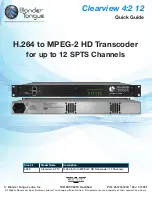
1
Safegua
rds
2
Terms and
Warranty
3
Principl
e o
f
Operati
on
4
Ins
talla
tion
5
Operati
on
6
C
ont
rol Syst
em
7
RF Componen
ts
8
Power
Supp
ly
9
Maintenan
ce
10
Troubleshoo
ting
Installation
This section contains installation recommendations, unpacking, inspection, and
installation instructions for the power amplifier or transmitter. We are sure that
you are chomping at the bit to install your new system, so we recommend that
you read the following sections very carefully.
Building Recommendations
The quality of the building is of great importance if you are to expect long life and
continued performance from the power amplifier or transmitter. The building must
be clean, dry, temperature controlled and secure. Don’t forget to allow space in
the building for any additional racks to house test equipment, a workbench area,
line regulating transformers, ladders, equipment and parts storage, first aid kit,
emergency generator if used, as well as heating and cooling devices that may be
unique to your installation. A beer fridge is optional. A sloping roof will tend to
develop leaks less rapidly. The building should be well roofed with good material.
The cooling load will be lowered with reflective or light colored roofing material.
Electrical Service Recommendations
Technalogix recommends that a qualified, licensed local electrician be consulted
for the required electrical service. We suggest local electricians because:
The personnel knows the local codes
The personnel can be on site readily
You are apt to get better overall support if you give what business you can
to local suppliers
Technalogix recommends that proper AC line conditioning and surge
suppression be provided on the primary AC input to the power amplifier or
transmitter. If DC is used as a source, a DC-DC converter is recommended to
provide isolation between the supply and the load. All electrical service should
be installed with your national electrical code in your area, any applicable
provincial or state codes, and good engineering practice. Special consideration
should be given to lightning protection of all systems in view of the vulnerability of
many sites to lightning. Lightning arrestors are recommended in the service
entrance. Gas Discharge Tubes (GDT) may help in preventing lightning, which
was forecast for another day, from creating a bad day. Straight and short grounds
are recommended. The electrical serviced must be well grounded. Do not
connect the unit to an open delta primary power supply, as voltage fluctuations
could harm the unit. Branch your circuits. Do not allow your lights, your
workbench plugs, and your transmitting or translating equipment to operate on
one circuit breaker. Each amplifier or transmitter should have its own circuit
breaker, so a failure in one does not shut off the whole installation.












































